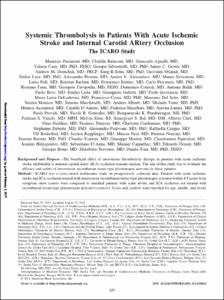Systemic Thrombolysis in Patients With Acute Ischemic Stroke and Internal Carotid ARtery Occlusion The ICARO Study
- Keimyung Author(s)
- Sohn, Sung Il
- Department
- Dept. of Neurology (신경과학)
- Journal Title
- Stroke
- Issued Date
- 2012
- Volume
- 43
- Issue
- 1
- Keyword
- carotid occlusion; outcome; thrombolysis; acute stroke
- Abstract
- Background and Purpose: The beneficial effect of intravenous thrombolytic therapy in patients with acute ischemic stroke attributable to internal carotid artery (ICA) occlusion remains unclear. The aim of this study was to evaluate the efficacy and safety of intravenous recombinant tissue-type plasminogen activator in these patients.
Methods: ICARO was a case-control multicenter study on prospectively collected data. Patients with acute ischemic stroke and ICA occlusion treated with intravenous recombinant tissue-type plasminogen activator within 4.5 hours from symptom onset (cases) were compared to matched patients with acute stroke and ICA occlusion not treated with recombinant tissue-type plasminogen activator (controls). Cases and controls were matched for age, gender, and stroke severity. The efficacy outcome was disability at 90 days assessed by the modified Rankin Scale, dichotomized as favorable (score of 0–2) or unfavorable (score of 3–6). Safety outcomes were death and any intracranial bleeding.
Results: Included in the analysis were 253 cases and 253 controls. Seventy-three cases (28.9%) had a favorable outcome as compared with 52 controls (20.6%; adjusted odds ratio (OR), 1.80; 95% confidence interval [CI], 1.03–3.15; P=0.037). A total of 104 patients died, 65 cases (25.7%) and 39 controls (15.4%; adjusted OR, 2.28; 95% CI, 1.36–3.22; P=0.001). There were more fatal bleedings (2.8% versus 0.4%; OR, 7.17; 95% CI, 0.87–58.71; P=0.068) in the cases than in the controls.
Conclusions: In patients with stroke attributable to ICA occlusion, thrombolytic therapy results in a significant reduction in the proportion of patients dependent in activities of daily living. Increases in death and any intracranial bleeding were the trade-offs for this clinical benefit.
- Keimyung Author(s)(Kor)
- 손성일
- Publisher
- School of Medicine
- Citation
- Maurizio Paciaroni et al. (2012). Systemic Thrombolysis in Patients With Acute Ischemic Stroke and Internal Carotid ARtery Occlusion
The ICARO Study. Stroke, 43(1), 125–130. doi: 10.1161/STROKEAHA.111.630624
- Type
- Article
- ISSN
- 0039-2499
- Appears in Collections:
- 1. School of Medicine (의과대학) > Dept. of Neurology (신경과학)
- 파일 목록
-
-
Download
 oak-aaa-4376.pdf
기타 데이터 / 904.44 kB / Adobe PDF
oak-aaa-4376.pdf
기타 데이터 / 904.44 kB / Adobe PDF
-
Items in Repository are protected by copyright, with all rights reserved, unless otherwise indicated.